
Learn about oral care for puppies and kittens, including information about braces and misalignments, periodontal disease, damaged teeth, and more.
If you have ever been on the other end of a mouthy puppy or kitten you are very aware of their teeth. You may even celebrate when the adult teeth come in. But there is a lot more to know about puppy and kitten teeth besides how sharp they are!
During a puppy's and kitten's growth period, it is important to monitor for developmental problems. But how do you know what is normal when it comes to their teeth and mouth?
There are some variations by breed, but kittens and puppies typically have the “baby” (deciduous) teeth visible and in place by eight weeks of age. For most kittens and puppies, 28 baby teeth will erupt between 3 and 6 weeks of age followed by 42 adult teeth pushing the baby teeth out between 4 and 7 months of age.
As a general rule, the first permanent teeth to come in are the upper center two incisors (the little nibble teeth between the upper canine teeth), which are typically visible at 4 months of age. These permanent incisors will be slightly larger than the baby teeth beside them. If you are trying to determine your puppy’s age, you can use the arrival of these teeth to fairly accurately determine that your pet was born four months earlier. Over the next 2 months, the deciduous teeth should fall out while new permanent teeth take their place.
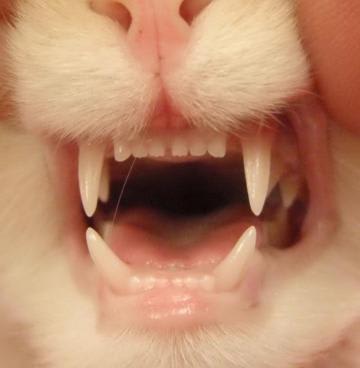
Young Cat's Normal Adult Teeth
Although your veterinarian will examine your puppy or kitten's teeth at each booster visit to determine if they are developing normally, you will want to monitor at home as well. Below are some of the most common problems in puppies and kittens. Please be aware that there are many more problems that are less common, so don’t hesitate to have your veterinarian check anything that does not seem quite right.
Retained Deciduous (baby) Teeth
Occasionally a permanent tooth will erupt beside a baby tooth, and the baby tooth can crowd the permanent tooth into the wrong position resulting in a malocclusion (or a bad bite) and early periodontal disease. When a deciduous tooth and the accompanying adult or permanent tooth can both be seen, the baby tooth should be removed quickly. You do not want the baby tooth to deflect the permanent tooth into an incorrect position. Also, when two teeth occupy the space meant for one tooth, food accumulates between them and periodontal disease and discomfort occur. Removing baby teeth typically requires anesthesia so the baby tooth can be removed completely.
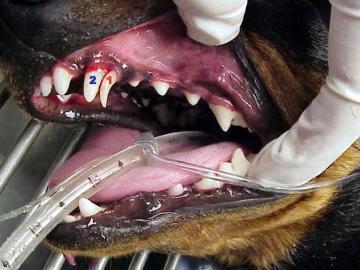
A red #1 baby tooth is pushing the blue #2 permanent tooth forward.
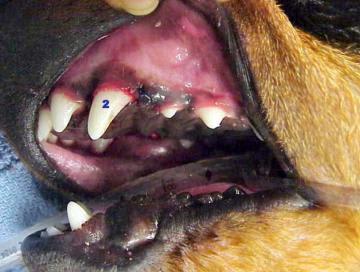
The retained baby tooth has been extracted.
Base Narrow Canine Teeth
In some puppies, one or both of the lower two canine/fang baby teeth and or permanent teeth will be positioned abnormally toward the center of the mouth. When these teeth fully erupt, they often poke into the roof of the mouth and can be very painful and cause infection. Addressing this problem when your pet is as young as possible makes it easier to correct.
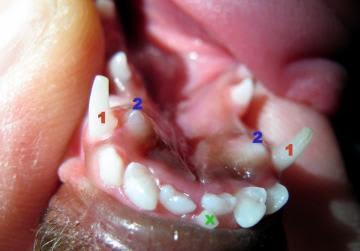
In the picture above, the red number 1’s are retained baby teeth. See how the permanent teeth, blue number 2’s have been pushed inward and when they fully erupt, they will poke into and damage the roof of the mouth. The green “x” is a baby incisor to be removed.
Periodontal Disease
Periodontal infection is the most common disease of dogs and cats in America – even more common than fleas. Eighty percent of dogs and seventy percent of cats have periodontal disease by 3 years of age. Gingivitis is often present by 1 year, and it can quickly progress to periodontal disease which affects oral health, oral comfort, and quality of life. Ideally, we never want tartar to form on your pet’s teeth SO PLEASE begin a home care program today before permanent changes begin.
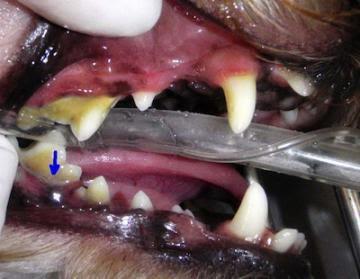
This photo shows that there was tartar on most of her teeth and that her gums were slightly swollen. Periodontal disease is there but it cannot be seen in this picture because it is below the gum line.
Missing Teeth
A puppy may be born without one or more teeth, which is not a problem. However, sometimes a tooth is “hidden” below the gum line and is termed non-erupted. If a tooth is not visible by 8 months of age, the area should be x-rayed since non-erupted teeth can form a cyst that can painlessly harm the jaw or even cause jaw fracture unless corrected.
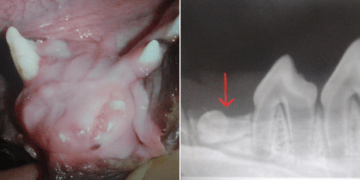
Fractured Teeth
Baby teeth and permanent teeth less than a year of age are weaker than adult teeth and very prone to fracture. The tooth will look broken or like it has a crack in it. A fractured tooth is ALWAYS painful and should be treated. Avoid HARD TOYS or FOOD such as real bones or deer antlers or any very hard substance to chew on.
Teething
Teeth pushing through the gums are painful and the pain is reduced by chewing on objects. Rawhide chews and soft toys seldom cause damage. Do not allow real bones, hard plastic chews, antlers or cow hooves as they often fracture or break teeth.
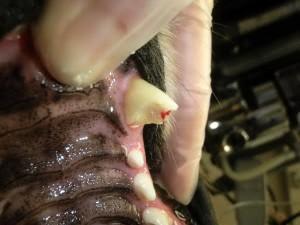
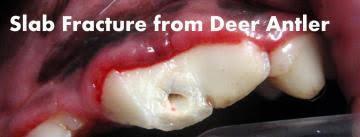
Malocclusions
Poorly aligned teeth are often a genetic problem starting at birth and may initially be subtle. The upper or lower jaw may be too long or short or one side of the mandible may be longer or shorter than the other. Many malocclusions require no intervention but others, such as dental interlock where the teeth can prevent the lower jaw from growing properly, require very early (6 to 8 weeks of age) intervention. Veterinary orthodontics are most often used to treat painful conditions to help the pet become more comfortable and functional and not for appearance.
Cleft Palate
This congenital deformity is a fissure or opening in the roof of the mouth, best treated in young pets. These can communicate into the nasal cavity and milk, water or food may come out of the nostrils.
Oral Exams for Puppies & Kittens
After the final boosters (about 4 months old) we recommend an oral exam around 6 months of age to assess that the baby teeth have come in correctly and no other dental concerns have occurred. Many kittens and puppies will be undergoing a surgical spay or neuter at this time. While they are here, our veterinarians can do a thorough oral exam. If there are a small number of retained baby teeth, there may be an option for removal under anesthesia at that time. We always hope that your puppy or kitten's teeth have developed normally and there are no concerns. If there are concerns you will receive recommendations for diagnostics (x-rays), and corrective options (removal of teeth or treatment options).
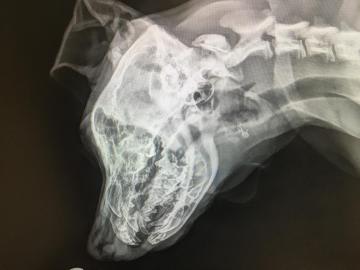
You can see the baby teeth and the nonerupted adult teeth in this x-ray.
Depending on the concerns and the recommendations, dental care may be something that will be able to be addressed during the anesthetic procedure or it may require you to schedule a separate anesthetic procedure. Please let us know your concerns at any time, especially prior to surgery, if you can see baby teeth, extra teeth, or anything else that looks strange to you. This will allow us to schedule more appropriately.
If your puppy or kitten has already been spayed or neutered, we can perform an oral exam at any time.
We encourage new puppy and kitten parents to immediately obtain a new pet toothbrush and the toothpaste that is specially designed and flavored for pets. They are both available here at Animal Hospital of North Asheville. You can start toothbrush training a puppy or kitten as early as 6 weeks of age. It is important to start the training off right, so please follow this link to learn more about how to train a puppy to like tooth brushing.
